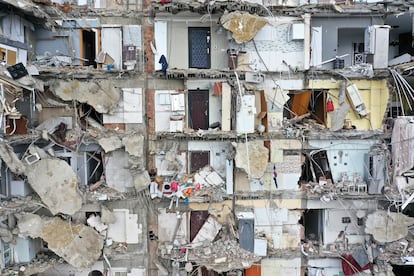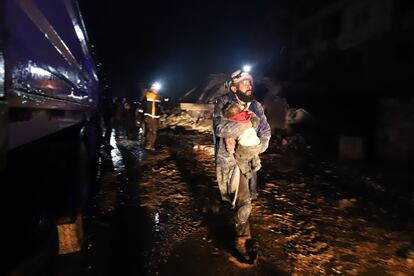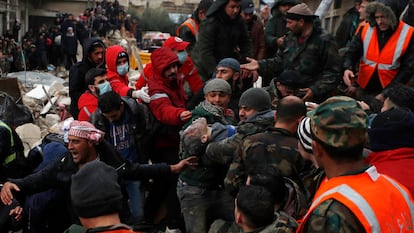Powerful quake rocks Turkey and Syria, kills more than 5,000
Turkish President Recep Tayyip Erdoğan has called it ‘the greatest tragedy’ since the great earthquake of Erzincan in 1939, which killed 30,000 people
A powerful 7.8 magnitude earthquake rocked wide swaths of Turkey and Syria early Monday, toppling thousands of buildings and killing more than 5,000 people. Hundreds were still believed to be trapped under rubble, and the toll was expected to rise as rescue workers searched mounds of wreckage in cities and towns across the area.
The number of injured individuals had climbed to 7,400 by Monday evening, and Turkish authorities said that 2,834 buildings had collapsed.
Turkish President Recep Tayyip Erdoğan has called it “the greatest tragedy” since the great earthquake of Erzincan in 1939, which killed 30,000 people.
On both sides of the border, residents jolted out of sleep by the pre-dawn quake rushed outside on a cold, rainy and snowy winter night, as buildings were flattened and strong aftershocks continued.
Rescue workers and residents in multiple cities searched for survivors, working through tangles of metal and giant piles of concrete.
In the Turkish city of Adana, one resident said three buildings near his home collapsed. “I don’t have the strength anymore,” one survivor could be heard calling out from beneath the rubble as rescue workers tried to reach him, said the resident, journalism student Muhammet Fatih Yavus. Further east in Diyarbakir, cranes and rescue teams rushed people on stretchers out of a mountain of pancaked concrete floors that was once an apartment building.

On the Syrian side of the border, the quake smashed opposition-held regions that are packed with some four million people displaced from other parts of Syria by the country’s long civil war. Many of them live in decrepit conditions with little health care. Rescue workers said hospitals in the area were quickly filled with the injured.
“Because the debris removal efforts are continuing in many buildings in the earthquake zone, we do not know how high the number of dead and injured will rise,” Erdoğan said. “Hopefully, we will leave these disastrous days behind us in unity and solidarity as a country and a nation.”
The quake, which was centered north of the Turkish provincial capital of Gaziantep, was felt as far away as Cairo. It sent residents of Damascus rushing into the street, and jolted awake people in their beds in Beirut.
It struck a region that has been shaped on both sides of the border by more than a decade of civil war in Syria. On the Syrian side, the swath affected is divided between government-held territory and the country’s last opposition-held enclave, which is surrounded by Russian-backed government forces. Turkey, meanwhile, is home to millions of refugees from that conflict.
The opposition-held regions in Syria are packed with some four million people displaced from other parts of the country by the fighting. Many of them live in buildings that are already wrecked from past bombardments. Hundreds of families remained trapped in rubble, the opposition emergency organization, called the White Helmets, said in a statement.
Strained health facilities and hospitals were quickly filled with wounded, rescue workers said. Others had to be emptied, including a maternity hospital, according to the SAMS medical organization.
The region sits on top of major fault lines and is frequently shaken by earthquakes. Some 18,000 were killed in a similarly powerful earthquakes that hit northwest Turkey in 1999. The US Geological Survey measured Monday’s quake at 7.8. At least 20 aftershocks followed, authorities said, including one that measured 7.5.

Thousands of buildings were reported collapsed in a wide area extending from Syria’s cities of Aleppo and Hama to Turkey’s Diyarbakir, more than 330 kilometers (200 miles) to the northeast. A hospital collapsed in the Mediterranean coastal city of Iskenderun, but casualties were not immediately known, his vice president, Fuat Oktay, said.
Televisions stations in Turkey aired screens split into four or five, showing live coverage from rescue efforts in the worst-hit provinces. In the city of Kahramanmaras, rescuers pulled two children alive from the rubble, while others tried to reach a relative.
Offers of help – from search-and-rescue teams to medical supplies and money – poured in from dozens of countries, as well as the European Union and NATO.
The damage evident from photos of the affected areas is typically associated with a significant loss of life – while bitterly cold temperatures and the difficulty of working in areas beset by civil war will only complicate rescue efforts, said Dr. Steven Godby, an expert in natural hazards at Nottingham Trent University.
In Turkey, people trying to leave the quake-stricken regions caused traffic jams, hampering efforts of emergency teams trying to reach the affected areas. Authorities urged residents not to take to the roads. Mosques around the region were opened to provide shelter for people unable to return to damaged homes amid temperatures that hovered around freezing.
The quake heavily damaged Gaziantep’s most famed landmark, its historic castle perched atop a hill in the center of the city. Parts of the fortresses’ walls and watch towers were leveled and other parts heavily damaged, images from the city showed.
In Diyarbakir, hundreds of rescue workers and civilians formed lines across a mountain of wreckage, passing down broken concrete pieces, household belongings and other debris as they searched for trapped survivors while excavators dug through the rubble below.
In northwest Syria, the quake added new woes to the opposition-held enclave centered on the province of Idlib, which has been under siege for years, with frequent Russian and government airstrikes. The territory depends on a flow of aid from nearby Turkey for everything from food to medical supplies.
The opposition’s Syrian Civil Defense described the situation there as “disastrous.”
Osama Abdelhamid, who was being treated for injuries at a hospital in Idlib, said most of his neighbors died. He said their shared four-story building collapsed just as he, his wife and three children ran toward the exit. A wooden door fell on them and acted as a shield.

“I was reborn, thank God,” he said.
In the small Syrian rebel-held town of Azmarin in the mountains by the Turkish border, the bodies of several dead children, wrapped in blankets, were brought to a hospital.
The Directorate-General of Antiquities and Museums in Syira said the earthquake has caused some damage to the Crusader-built Marqab, or Watchtower Castle, on a hill overlooking the Mediterranean. Part of a tower and parts of some walls collapsed.
The USGS said the quake was centered about 33 kilometers (20 miles) from Gaziantep. It was 18 kilometers (11 miles) deep.
More than 900 people were killed in 10 Turkish provinces, with more than 5,400 injured, according to Turkey’s president. The death toll in government-held areas of Syria climbed over 330 people, with some 1,000 injured, according to the Health Ministry. In rebel-held areas, more than 200 people were killed, according to the White Helmets, though the SAMS medical organization put the toll at more than 135; both said hundreds were hurt.
Huseyin Yayman, a legislator from Turkey’s Hatay province, said several of his family members were stuck under the rubble of their collapsed homes.
“There are so many other people who are also trapped,” he told HaberTurk television by telephone. “There are so many buildings that have been damaged. People are on the streets. It’s raining, it’s winter.”
Turkey sits on top of major fault lines and is frequently shaken by earthquakes. Some 18,000 were killed in powerful earthquakes that hit northwest Turkey in 1999.
Sign up for our weekly newsletter to get more English-language news coverage from EL PAÍS USA Edition
Tu suscripción se está usando en otro dispositivo
¿Quieres añadir otro usuario a tu suscripción?
Si continúas leyendo en este dispositivo, no se podrá leer en el otro.
FlechaTu suscripción se está usando en otro dispositivo y solo puedes acceder a EL PAÍS desde un dispositivo a la vez.
Si quieres compartir tu cuenta, cambia tu suscripción a la modalidad Premium, así podrás añadir otro usuario. Cada uno accederá con su propia cuenta de email, lo que os permitirá personalizar vuestra experiencia en EL PAÍS.
¿Tienes una suscripción de empresa? Accede aquí para contratar más cuentas.
En el caso de no saber quién está usando tu cuenta, te recomendamos cambiar tu contraseña aquí.
Si decides continuar compartiendo tu cuenta, este mensaje se mostrará en tu dispositivo y en el de la otra persona que está usando tu cuenta de forma indefinida, afectando a tu experiencia de lectura. Puedes consultar aquí los términos y condiciones de la suscripción digital.
Últimas noticias
Welcome to the post-religion era: The idea of Christianity as the absolute truth has become obsolete
‘I thought you would like it’: The risky sexual practice popularized by TV shows and TikTok
The digitalization of tourism: ‘They promise experiences and gave us the worst possible one’
Mexican peso defies uncertainty with forecasts of a new period of stability in 2026
Most viewed
- Sinaloa Cartel war is taking its toll on Los Chapitos
- Oona Chaplin: ‘I told James Cameron that I was living in a treehouse and starting a permaculture project with a friend’
- Reinhard Genzel, Nobel laureate in physics: ‘One-minute videos will never give you the truth’
- Why the price of coffee has skyrocketed: from Brazilian plantations to specialty coffee houses
- Silver prices are going crazy: This is what’s fueling the rally









































